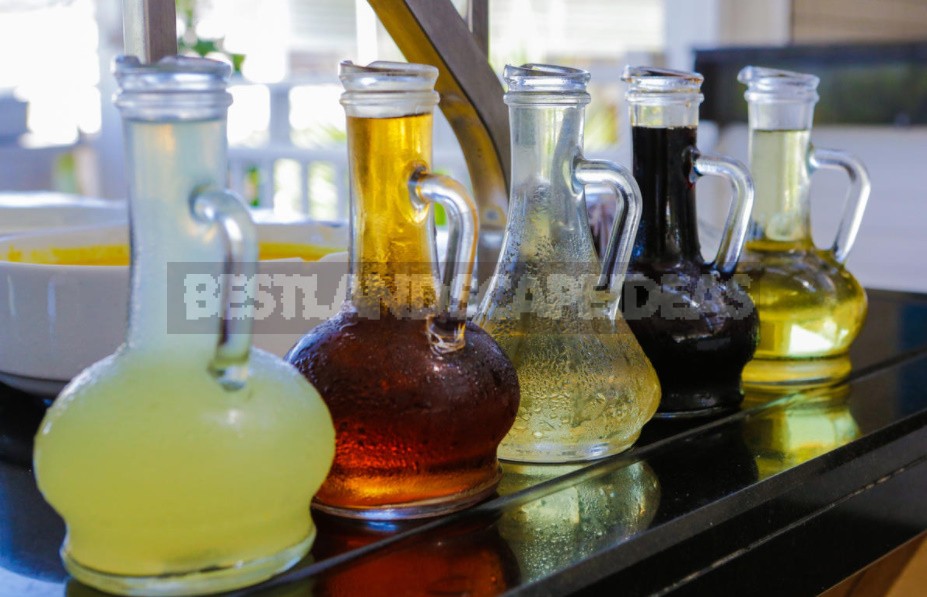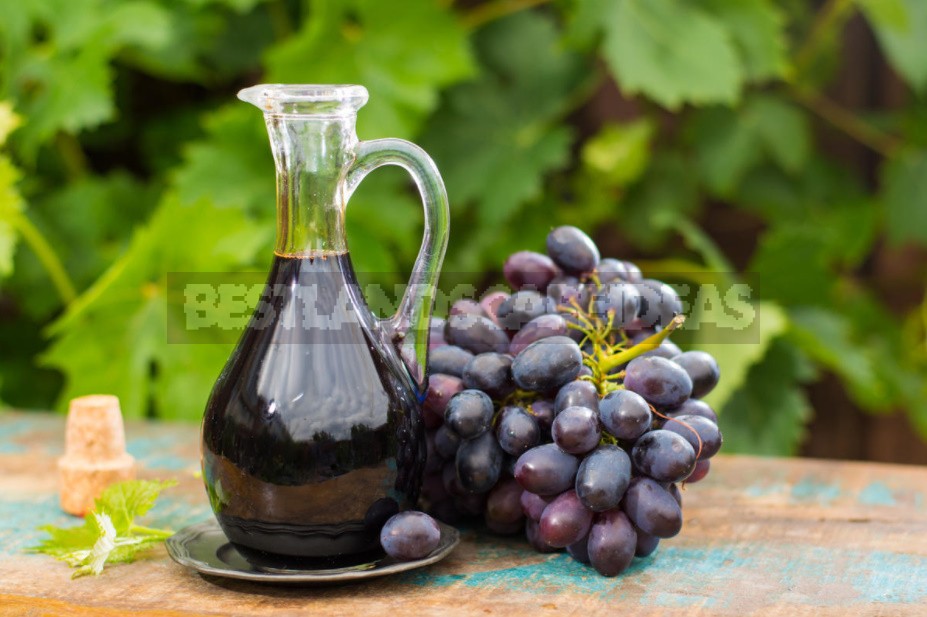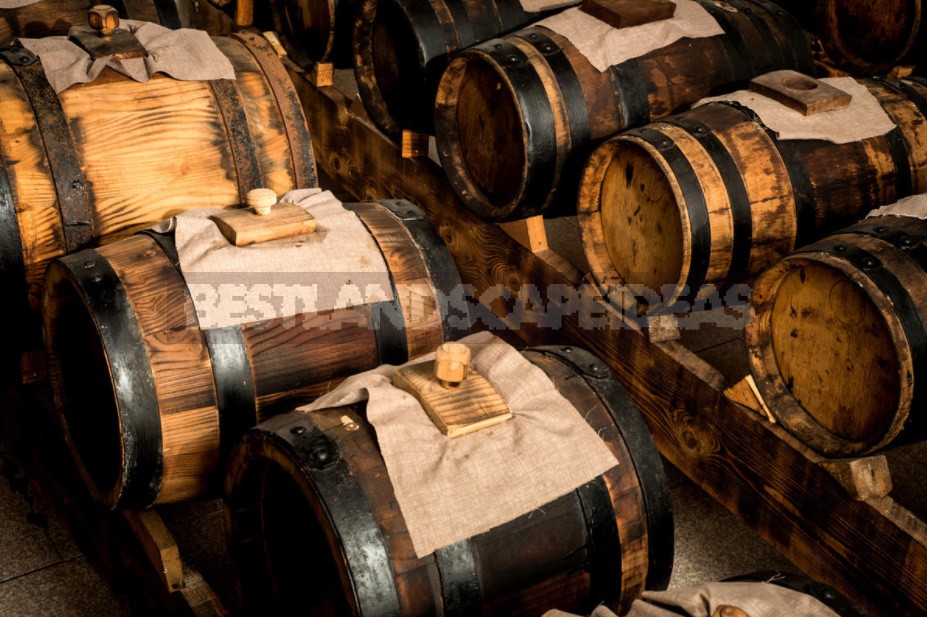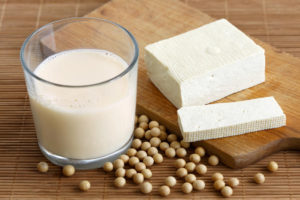
Wine or grape vinegar
It is obtained as a result of acetic acid fermentation of grape wine or purposefully prepared from grape juice or pulp left over from the processing of berries. The technology is generally similar to that used for the preparation of fruit and berry vinegar, only the proportions change (which, in turn, depend on the quality of the raw material). Instead of sugar, you can use honey-this enriches the finished product and makes it taste softer, more harmonious.

Wine vinegar is used in folk medicine externally-for gargling with angina (2 tablespoons of vinegar for 1 Cup of warm boiled water), rubbing and lotions for joint diseases. Inside, a weak vinegar solution (2 teaspoons per 1 Cup of boiled water, drink small SIPS 1 time a day-after Breakfast, the course is 2 weeks) is taken for chronic fatigue; violation of the gastrointestinal tract against the background of low acidity of gastric juice; obesity.
In cooking, wine vinegar is used to prepare various sauces, salad dressings, as well as in meat, fish, and vegetable dishes.
Balsamic vinegar
It is called the king of vinegars and has been used in folk medicine since Ancient Rome. Real, high-quality balsamic vinegar is not cheap, but it is a reasonable price. It is prepared only from certain grape varieties, the berries of which are collected overripe, raw materials are processed using a special technology, and then the wort is aged in special barrels made of different types of wood for at least 12 years. As you can imagine, you will not be able to reproduce this process at home.

Balsamic vinegar has a rich dark color, an expressive aroma with woody notes and an original sweet and sour taste. Avoid cheap fakes and imitations containing all kinds of dyes and preservatives!
Natural balsamic vinegar has a pronounced anti-inflammatory and antiseptic effect. It was used for treating wounds, disinfecting water, and treating various diseases. Nowadays, it is used mainly for culinary purposes: it is added to ready-made dishes (including desserts), sauces, marinades, etc.
National tradition
Many peoples of the world have their own, original recipes for vinegar, which is made from local raw materials. So, in Japan and China, rice vinegar of various varieties is widely used (some of them taste a little like balsamic). It is prepared from different types of rice, sometimes adding herbs, so the properties and taste nuances may vary markedly. A weak aqueous solution of this vinegar is used as a refreshing drink; this vinegar is added to rice dishes, salads, and used for marinating meat.

In England, malt vinegar is popular, which is best combined with fish dishes. It is made from beer wort; the finished product usually has a brown or Golden-yellow color, a characteristic aroma with fruit or caramel notes and a soft taste.
In General, what do not make vinegar! In ancient Babylon, which is considered the birthplace of vinegar, it was made from dates (and in some countries it is still made today). In the Philippines and Indonesia, cane vinegar is used. It is also made from whey, alcohol, and other raw materials. You can try cooking at home, for example, Jerusalem artichoke vinegar.
Jerusalem artichoke vinegar
- 1 kg of fresh Jerusalem artichoke tubers;
- 1 liter of water;
- 100 g of sugar;
- 20 g of fresh yeast.

Wash and chop the Jerusalem artichoke thoroughly, pour in water, add sugar and yeast. The container is tied with gauze, folded in several layers, and left for 2 months in a warm dark place. Filter, bottle, and seal well. Store in a cool dark place, use externally: for rubbing sore joints.
As you can see, the range of natural vinegars is extremely wide, and many types can be successfully made independently at home. And it is not necessary to use them as medicine — even if you just replace the harmful synthetic vinegar in the kitchen with any natural one, the body will be grateful to you.
How to choose natural vinegar
Of course, the most reliable way to get natural vinegar is to prepare it yourself: in this case, you can be completely sure of the raw materials used. However, some types of vinegar (for example, balsamic) can not be made at home, so you will have to go to the store for such a product. But unfortunately, what is on the shelves can not always be called a natural product — and only this vinegar is useful!
What to pay attention to and how not to make a mistake when choosing? First, of course, carefully read what is written on the label: natural vinegar of any kind should not contain any dyes, preservatives, flavorings and other artificial additives.
Secondly, you should pay attention to the price tag: this is exactly the case where price and quality are often linked — for example, inexpensive balsamic vinegar will almost certainly turn out to be a fake. Third, the appearance of the product can give a hint: vinegar of a defiantly bright, rich color, and even poured into plastic bottles, is unlikely to be natural. By the way, keep in mind that for some types of vinegar, a small precipitate is not a disadvantage — rather, its absence should alert you.
Contraindications to the use of vinegar
Despite the fact that natural vinegar, of course, is much more useful than synthetic (in relation to which it is hardly possible to talk about the benefits), you should not abuse this product. Any excessive use of vinegar, regardless of its quality and type, can harm your health.
Completely exclude all types of vinegar from the diet is recommended for peptic ulcer of the stomach and duodenum, gastritis, hepatitis, cholecystitis. It is not recommended to take vinegar for weight loss or treatment of any diseases without first consulting your doctor.




Leave a Reply